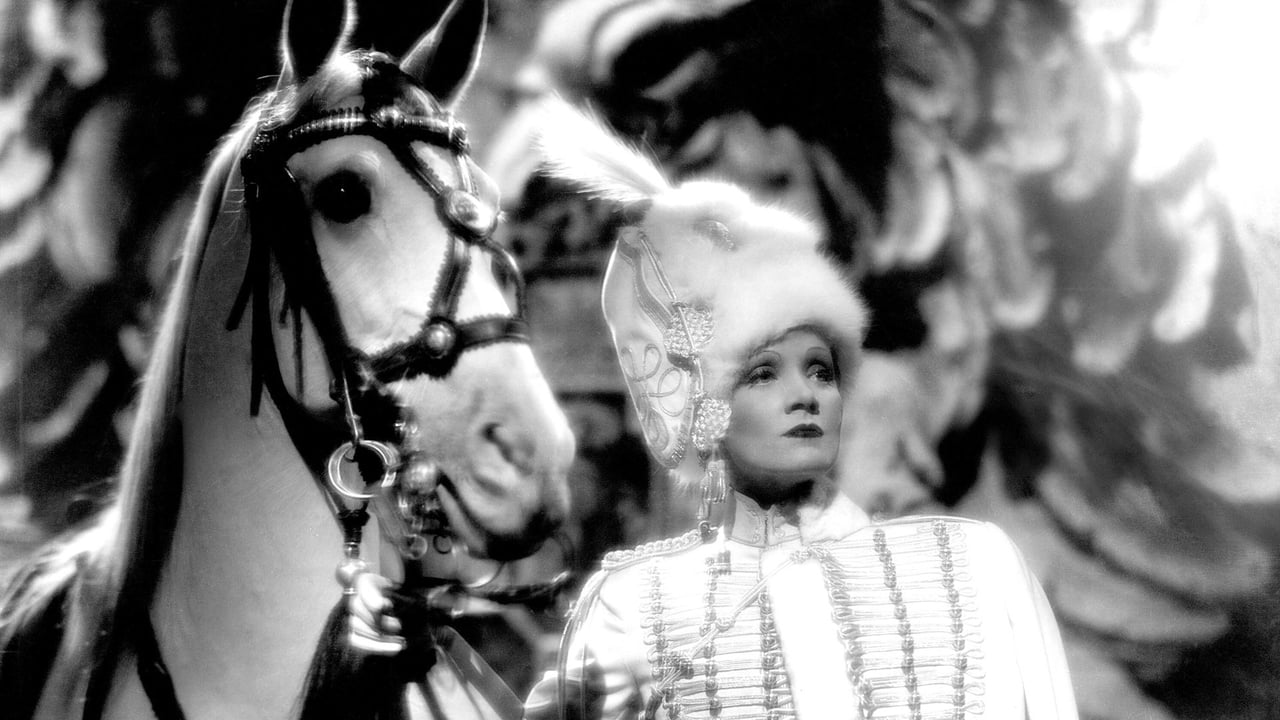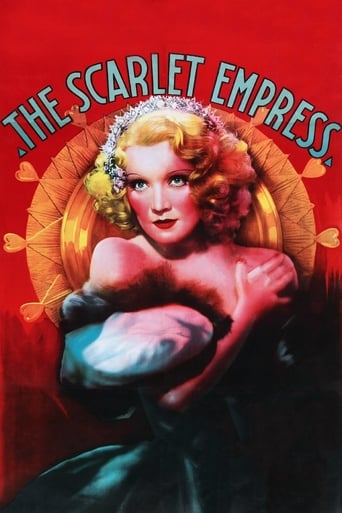



I love this movie so much
Just perfect...
Expected more
A Major Disappointment
Boasting a supporting cast of 1000 extras - 1934's "The Scarlet Empress" was, to me, nothing but a stuffy, boring, pretentious costume drama which was clearly intended as a vehicle to glorify Marlene Dietrich and present her as a serious dramatic actress.Apparently based on the actual diary entries of Catherine II - I thought that (under the heavy-handed direction of that lunatic eccentric, Josef Von Sternberg) ""The Scarlet Empress" (with its million dollar budget), pretty much, amounted to being nothing but a total mockery of Russian history from start to finish.This was clearly one of those films that (because it took itself so bloody serious) ended up being downright laughable, in the long run.*Note* - As expected - Marlene Dietrich does her celebrated "man-drag" shtick in this picture, as well. (Ho-hum!)
View MoreImagine a staircase leading to an open window. A bright light leaks from its center, white doves flying in in hopes to escape the snowy cruelty of the outside. Flowery confetti fills the atmosphere, spinning around in the circling draft of the wind; a gold silken sheet floats down the staircase with the slink of a python on the prowl. Spotted horses, covered in the furs of their master, stand alongside its initial steps, providing company for the lonely statues that adorn the corridor. As we stumble into this foyer, lost in a labyrinth of style, we're both transfixed and horrified, hypnotized by its incandescent beauty, sickened by its seemingly unrelenting movement.Such disquieting allure infects "The Scarlet Empress", an epic in style over substance that uses the scheme of a biopic to give itself an excuse to call itself a movie. In reality, it's a moving painting: every scene is so crammed with ornate decor (ominous gargoyles, gnarled furniture, eye-clogging ball gowns) it's as though Leonardo Da Vinci was asked to set an empress' likeness in stone and ended up exhausting himself through a lavish series of works, dying from an overworked heart at its conclusion."The Scarlet Empress" is a carnival of decoration, born as the daughter of a hoarder with a mystical eye and dying as one of Prince's jilted lovers. The film begins beautifully and ends beautifully, but changing is its initial feeling of enchantment, which slowly descends into a pit of contorted exoticism. A terminal case of style over substance can sometimes work, but "The Scarlet Empress" is all style and no substance, the style being the result of a drug- induced fever dream. It's as if von Sternberg purchased a studio apartment and decided to fill it with a family of hot pink elephants. But the film is made with a great deal of sensibility, and that's why its cloying ornamentation endures as such a lastingly daring experiment 80+ years later. So much of its outrageousness is done for the sake of simply doing it — doors are so meaty they require six well-dressed women to open them; Marlene Dietrich changes outfits at such an obsessive pace that loudness becomes a given, untouchable furs become a benchmark. Von Sternberg knows that these things provide for interesting fixtures to the eye, and is relentless with how much is put onto the screen. It's a conscious dedication, and it's riveting, however tiring it eventually becomes."The Scarlet Empress" is a "biopic", its heroine being Catherine the Great, portrayed by a meticulously photographed Dietrich. The film focuses on her transformation from innocent high society daughter to supremely sexual, ultra-cruel dominatrix. She is forced to marry the idiotic Peter (Sam Jaffe), but as her marriage progresses the more she coats in her confidence, lining up man after man to fulfill her most dreamy of desires.The movie isn't a precisely researched source for the history books; it's a vehicle in which von Sternberg is able to go mad with every stylistic inhibition he has ever repressed, a vehicle for Dietrich to seal herself as a screen vamp for an eternity. She does not have to be an actress here — von Sternberg fondles her with his camera, bringing an unseen animal attraction to her erotic face, placing her in a room as though she is the center of the assorted configurations of decoration."The Scarlet Empress" was released just as the Hays Code was beginning to prosper, allowing for sexuality to ooze off the screen while retaining a snarky sense of bawdy humor. Dietrich is an actress whose persona feeds on sensuality — a film like this suits both her and von Sternberg's ebullient talents. With no story to speak of, the film often leans toward the unexciting (style can only enrapture for so long before it begins to wane), but it's momentous that the movie, almost a century old, was so ballsy in its design in a time where money spoke and artistry started as a whisper.
View MoreI saw "The Scarlet Empress" many times. On TV, in movie theaters. I cannot simply imagine the world without that film, certainly in my Top Ten Favourites list.Style is the first word that came to my mind when I think of von Sternberg (he added the von to his name but he clearly deserves it). And "The Scarlet Empress' is purely "un exercice de style". People often use the concept of "Expressionism" to describe the photography or the ambiance of the film but it is simply because it is not a classical Hollywood movie in style or in atmosphere. There is nothing strictly "Expressionist" in "The Scarlet Empress" as the expression of emotions is definitely secondary to the creation of a style as a "raison d'etre". The early years of Catherine the Great (before she even become Catherine the Great) as described by von Sternberg are not corresponding to a strict historical version. This is not the point. This is about the transformation of a woman from a tender, naive and gentle "Prussian rose" into a Machiavelian, merciless praying-mantis, cold as steel, hot as Hell. It is probably a bit stretched, but I find a lot of similarities between the depiction of how Sophia Frederica became Catherine the Great and the personal story of Marlene Dietrich. When she was chosen by von Sternberg for the role of Lola Lola, she was active in German show business for years. At that time, she was a bit plump, more "the girl next door" than "she who must be obeyed". Then, "Der Blaue Engel". Then Hollywood, a few more movies with her "creator" and the woman became Legend, something out of this world.in a way, the character played (quite well) by John Lodge reminds me of von Sternberg in front of Marlene. When Sophia Frederica sees the handsome, dashing and fascinating Russian envoy, it is Marlene at the time where she was just another actress in the boiling last years of the Weimar Republic. The Count seduces her, makes her falling for him (easily after she discovered her future husband is a raving maniac looking like a monkey on acid). And then, the brutal wake-up: he is the lover of the reigning empress! The little princess throws her broken heart in the sewer and decides to reject everything she was previously: a bit like what did "La" Dietrich after she arrived in Hollywood. And this is were I see the comparison between the character of John Lodge and von Sternberg. Von Sternberg tried to keep the evasive Marlene under his spell for years, making six more movies with (for) her. But she was far away already, long ago. And the face of John Lodge when he discovers than he will never be Catherine the Great's lover, simply because he played with her heart and betrayed her naive love, is a kind of symbol of the filmmaker losing his grip on his creature. But was she ever HIS creature?Of course, Marlene dominates the film. She is radiant, more beautiful and glamorous than in any other movie. She is also excellent. She plays, at 33, the young, virginal princess very convincingly, her great doe-like eyes constantly moving from one surprise to another. After the betrayal of the man she thinks she loves, she becomes a kind of Nietschian character, bigger than life, cynical and ruthless. But the close-up of her face, after she dismissed John Lodge and now waits for the Count Orlov, her new caprice, shows a distressed woman. A woman who was betrayed by her first love, and whose revenge is bitter-sweet, if not pathetic.The other actors are all brilliant but Louise Dresser as the empress Elisabeth and Sam Jaffe as the Grand Duke Peter, respectively mother in law and husband of Catherine, are particularly outstanding. Louise Dresser plays herself a cynical and ruthless empress who knows her weaknesses but put the destiny of Russia about everything. Sam Jaffe, well, was the character actor by excellence, able to play a Russian Grand Duke or Gunga Din. His Peter is an absolute maniac but he manages to make him more pathetic and pitiful than monstrous. In the end, he is a poor fellow too small for his own crown. You feel almost sorry for him when he dies.Von Sternberg acted as a real demiurge in this movie, controlling/creating everything: lights, camera angles and moves, sets and costumes. It gives to the movie this extraordinary atmosphere not only of total art but of fantasy as well (the scenes of rapes and tortures could not have been made six months later, many thanks to the Hays Code). It is extremely claustrophobic in spite of the size of the sets as almost all the action occurs in the imperial palace which looks like a Gothic castle, Russian style.During the wedding scene, one cannot forget the close-up on Marlene's face, her eyes terrified and fascinated as well, and the flame of the candle in her hand bending under her invisible breath, like a heartbeat.
View MoreRarely do I respond like this to a film from this era! How on earth this piece of surreal art got made is astounding! The art direction, the costumes, the huge sets and outlandish props, the lighting (so many candles!), the visual effects, the great camera movement. All way ahead of its time.And Paramount executives approved all this grotesqueness? Well, someone at Paramount had the sense to allow it all to get the green light! And Sternberg--what medications was he on? The horse symbols well, we can all speculate what was going on there. But insanely as everything is, it is great cinema indeed. Several references I checked called this an historical drama! I was laughing so much through this film, I thought for sure it must be high comedy. The category doesn't matter today...it's just a great camp film and absolutely requires multiple viewings to take it all in.I loved Dietrich so much here...those eyes! What actress today would dare to be so effective in non-speaking camera shots...she is so demure and quiet in the opening half of the film!..so subtle and smouldering underneath and beautiful..Glennon filmed her so exquisitely with his lighting camera-work (Sternberg was also a master of lighting). Just like William Daniels whose camera fell in love with another goddess (Garbo).I can't recommend this film enough!! My only complaint is that the opening credits did not credit the art directors,costumes,film editing, etc. nor the great music used (yes they are re-arranged selections from Tchaikovsky,Wagner, etc.) but who arranged it all in the first place? Was it Sternberg? Anyway, superb use of the music for its time.An absolutely unbelievable film and the pace never lets up for one minute!!! Some earlier Sternberg entries lagged in places and made me sleepy. Not this one! We will never see anything like this again!
View More